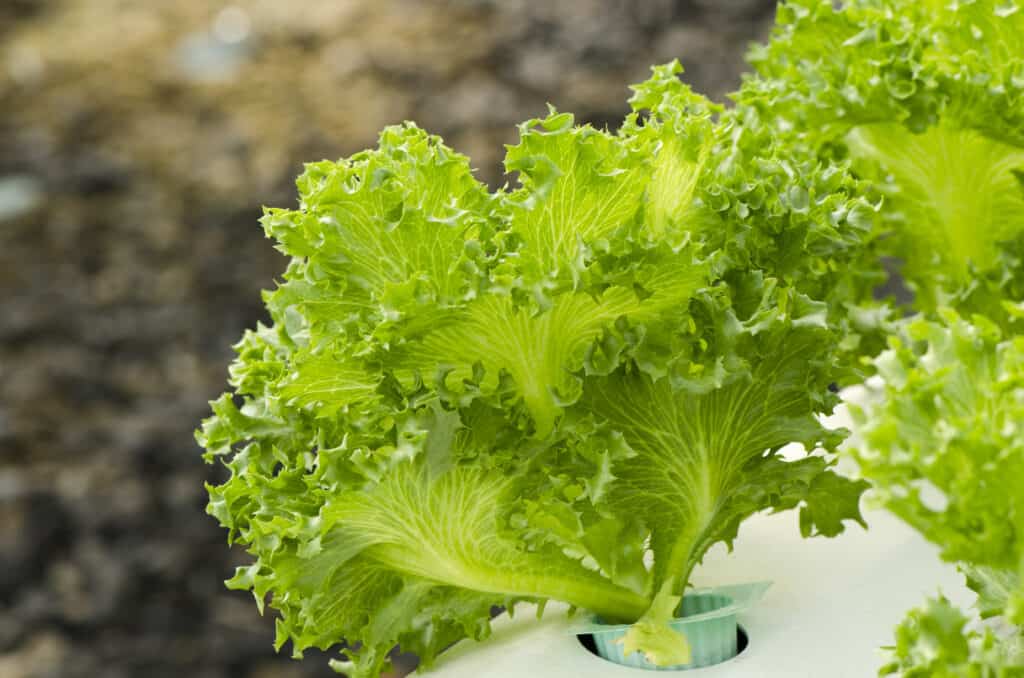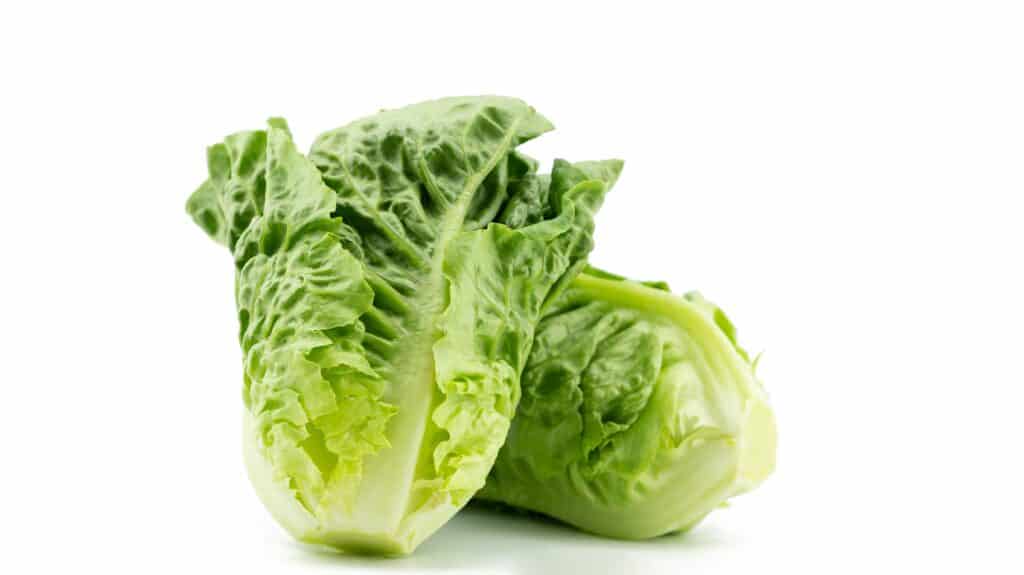If you’re interested in growing different varieties of lettuce or increasing your salad intake, you might be wondering about the difference between green leaf and romaine lettuce. While these lettuce varieties may look similar at first glance, they have distinct physical characteristics, tastes, textures, and culinary uses.
In this comparison guide, we’ll discuss the similarities and differences between these two plants, how they’re classified, their culinary uses, and nutritional facts. We’ll also provide growing and plant care tips. So, without further ado, let’s dig in!
Green Leaf Lettuce vs. Romaine: A Quick Look
| Green Leaf Lettuce | Romaine Lettuce | |
|---|---|---|
| Plant Classification | Lactuca sativa var. crispa | Lactuca sativa L. var. longifolia |
| Plant Description | The base is narrow and fans out to form a loose, wide rosette shape. Leaves are tender and delicate. Up to 8 inches tall at maturity | The base is narrow and the smooth, long leaves form an elongated oval or soft v shape. Up to 15 inches tall at maturity. |
| Culinary Uses | Mild flavor. Leaves are tender and moist. Good for balancing spicier or nuttier-tasting lettuces. Great for use in mixed salads and sandwiches. | Crisp texture and fresh, slightly bitter flavor. Leaves are less moist than green leaf lettuce. Good for use in salads and sandwiches. Can even be grilled. |
| Nutritional Facts | Great source of vitamin K and A. Also a good source of lutein and zeaxanthin. | Great source of vitamin K, A, and folate. Also a good source of lutein and zeaxanthin. |
| US Growing Zones and Growing Tips | Hardy to grow in zones 2-11. Cold hardy. Prefers well-draining, moist soil with a neutral pH. | Hardy to grow in zones 2-11. Cold hardy. Prefers well-draining, moist soil with a neutral pH. |
The Key Differences Between Green Leaf Lettuce and Romaine Lettuce

Green leaf lettuce often forms as a dense head of leaves.
©wasanajai/Shutterstock.com
The main differences between green leaf lettuce and romaine lettuce is their shape and color. Romaine lettuce is darker than green leaf lettuce. It is also an elongated oval shape compared to the dense head or rosette shape of green leaf lettuce.
Green Leaf Lettuce vs. Romaine: Plant Classification
Both green leaf lettuce and romaine lettuce belong to the same genus and species, Lactuca sativa. Both romaine and green leafy lettuce belong to the Asteraceae family.
Within this species, there are four main cultivated botanical varieties: leaf lettuce (var. crispa), celtuce lettuce (var. augustana), head, or cabbage, lettuce (var. capitata), and romaine, or cos, lettuce (var. longifolia). Green leaf lettuce belongs to the crispa variety and romaine lettuce belongs to the longifolia variety.
Considered one of the oldest forms of cultivated lettuce, romaine lettuce, or cos lettuce, is thought to have originated in Egypt where it then spread to the Greek island of Cos about 5,000 years ago. The name, romaine, comes from the ancient cultivation of this lettuce in the garden of the Roman pope. Ancient Egypt is also considered the site of origin for leafy green lettuce. The lettuce was cultivated not just for its edible leaves, but also for its seed oil.
Green Leaf Lettuce vs. Romaine: Appearance
Green leaf lettuce and romaine lettuce are relatively easy to distinguish from each other based on their physical characteristics. Both are narrower at the base, but from there, their differences are pretty stark.
Green leaf lettuce forms either a dense head or loose rosette shape and leaves can present as either curled or smooth. Its color tends to be light lime green with white ribbing that tapers off at its midsection.
Romaine lettuce forms an elongated oval shape with slightly curled leaves along its edges. The color tends to be a bit darker than green leaf lettuce and the leaves appear firmer. Romaine lettuces feature a white-yellow rib that runs along its entire length. This gives romaine its distinctive crunchiness.
Green Leaf Lettuce vs. Romaine: Culinary Uses
Both lettuces are widely popular for their culinary uses. Green leaf lettuce is a great choice for salads and sandwiches. It has a milder flavor than romaine lettuce. As such, it’s excellent for people who want this lettuce’s refreshing and slightly crisp texture in a dish without a strong flavor. If you’re looking for more flavors in a green leaf salad, you can always add in lettuces that have more nutty or bitter notes.
In comparison, romaine lettuce has a stronger flavor than green leaf lettuce with more bitter notes. Some people love bitter notes in their greens and romaine adds a great hint of this flavor without being overwhelming. Its leaves are also a bit crispier than green leaf lettuce, and it can bring lots of crunch to a salad or sandwich if you use the ribs that run along its length.
Because romaine has such firmness, it’s actually an excellent choice for grilling! People tend to grill the inner core of the romaine, referred to as romaine hearts. This core is much denser and firmer, making it perfect for grilling.
To grill:
- Chop off the softest couple of inches at its head and remove the outer layers.
- Prepare a vinaigrette of olive oil, vinegar, your choice of herbs, salt, and pepper.
- Paint the romaine hearts with the vinaigrette.
- Grill the lettuce on high heat for a couple of minutes on each side. The sides should have lovely brown sear marks on all sides.
- Serve whole or chopped and enjoy!
Green Leaf Lettuce vs. Romaine: Nutritional Facts and Health Benefits

Romaine lettuce is packed full of nutrients which makes it a popular food choice.
©2158916329/Shutterstock.com
Green leaf lettuce provides a hardy source of vitamins A and K. Additionally, its also a great source of lutein and zeaxanthin. Lutein and zeaxanthin are carotenoid antioxidants that are particularly beneficial in promoting eye health. A one-cup serving contains 5 calories, 40% of the daily recommended vitamin A intake, and 15% of vitamin K.
Romaine lettuce is a great source of vitamins A, K, and folate (vitamin B-9). Like green leaf lettuce, it also provides an excellent source of eye-protecting antioxidants lutein and zeaxanthin. A one-cup serving of romaine lettuce contains 10 calories, 25% of recommended daily vitamin A intake, and 40% of vitamin K. Comparatively, you’ll notice that romaine lettuce is most beneficial for vitamin K intake, while green leaf lettuce is most beneficial for vitamin A intake.
Green Leaf Lettuce vs. Romaine: U.S. Growing Zones and Plant Care Tips
Thankfully for northern growers, lettuces tend to be rather cold-hardy, and green leaf and romaine are no exception. You can grow both romaine and green leaf lettuce in USDA growing zones 2-11. When sowing seeds or planting, just make sure to research your specific growing zone to know what time of year to plant in your area.
Since lettuces have a shallow root system, you can easily grow them in pots or raised garden beds. Both romaine and leafy green lettuce require at least five hours a day of direct sunlight to thrive. During the summer, especially in warmer climates, they can benefit from light afternoon shade and soil mulching. They prefer moist, well-draining soil with a neutral pH. Loamy soil is particularly well-suited to growing lettuce, as the soil can retain moisture without becoming water-logged.
Because lettuce is so cold-hardy, you can plant them once in the spring and again in the late summer for two harvests. Lettuce seeds may not germinate well in soil temperatures above 75 degrees, so transplanting young romaine and leafy green plants into your late summer garden can produce better results than direct sowing. Compared to green leafy lettuce, romaine is much more tolerant of heat and can produce well in warmer climates, especially when the soil is mulched.
When planting seeds in the spring, expect leafy green lettuce to take about 65-80 days to mature. In the fall, green leafy lettuce can take about 105 days to mature. Romaine lettuce can take about 65-70 days to mature when grown from seed in the spring, and about 90 days to mature in the fall.
Up Next:
- Iceberg Lettuce vs. Cabbage: 5 Key Differences
- Can Dogs Eat Lettuce? It Depends on How It’s Been Prepared
- Cabbage vs. Lettuce: 5 Key Differences
The photo featured at the top of this post is © 2158916329/Shutterstock.com
Sources
- North Carolina State Extension, Available here: https://plants.ces.ncsu.edu/plants/lactuca-sativa/
- Only Foods, Available here: https://www.onlyfoods.net/types-of-lettuce.html
- Lettuce Info, Available here: https://lettuceinfo.org/products/romaine/
- Missouri Botanical Garden, Available here: https://www.missouribotanicalgarden.org/PlantFinder/PlantFinderDetails.aspx?kempercode=a679
Thank you for reading! Have some feedback for us? Contact the AZ Animals editorial team.







